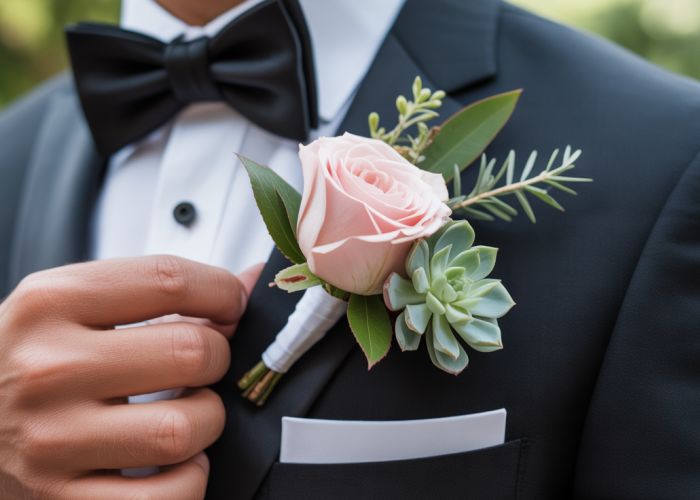Achieving the perfect placement of boutonniere is simpler than you might think, and this guide is here to help. Weddings, often celebrated with meticulously planned details, rely heavily on visual harmony, and the positioning of a boutonniere plays a crucial role. Florists provide the beautiful blooms, but it’s your understanding of lapel anatomy that ensures proper adornment. The groom, as a central figure, benefits immensely from knowing the best approach to wearing this floral accent.

Boutonniere Placement: A Simple Guide to Getting It Right
The placement of boutonniere is crucial for completing a formal look. More than just sticking it on, understanding the correct position ensures it enhances the outfit, stays secure, and looks its best in photos. This guide will walk you through the best practices.
Understanding the Anatomy of a Boutonniere
Before we delve into placement, it’s helpful to know what makes up a boutonniere.
- The Flower: This is the main focal point, usually a single bloom or a small cluster of flowers.
- The Stem: This part is wrapped and provides the structure for attaching the boutonniere.
- The Pin(s): These are essential for securing the boutonniere to the lapel.
The Ideal Placement of Boutonniere: Step-by-Step
The correct placement of boutonniere is on the left lapel of a suit jacket, tuxedo, or even a more casual blazer. Here’s a step-by-step approach:
-
Identify the Lapel: Locate the left lapel of the jacket. It’s the folded flap of fabric below the collar.
-
Find the Buttonhole (If Present): Some jackets have a buttonhole specifically designed for boutonnieres. If there is one, it’s usually found on the upper part of the lapel. If a buttonhole exists, thread the stem of the boutonniere through it.
-
Positioning Without a Buttonhole: If there’s no buttonhole, place the boutonniere on the upper left lapel, just below where a buttonhole would be. The flower should sit approximately halfway between the lapel’s edge and the collar.
-
Securing the Boutonniere with Pins: This is where the placement of boutonniere becomes crucial to its stability.
- From the Back: Insert a pin from the back of the lapel, up through the fabric, and then catch a small portion of the boutonniere’s stem. Bring the pin back down through the lapel.
- Angle Matters: Angle the pin slightly downwards to help secure the boutonniere firmly against the lapel.
- Number of Pins: Use at least two pins for adequate security, especially for larger or heavier boutonnieres. A third pin might be necessary for added stability. Position the second (and potentially third) pin below the first, ensuring the stem is securely fastened to the lapel.
- Conceal the Pins: The goal is to keep the pins hidden from the front as much as possible. They should primarily be visible from the back of the lapel.
Different Jacket Styles and Placement Considerations
While the general placement of boutonniere remains consistent, minor adjustments might be needed based on the jacket’s style.
Notched Lapel
This is the most common type of lapel and the easiest to work with. Follow the standard placement guidelines above.
Peaked Lapel
These lapels are wider and point upwards towards the shoulders. Place the boutonniere slightly higher up the lapel compared to a notched lapel, following the same principles of pinning.
Shawl Lapel
Typically found on tuxedos, shawl lapels are rounded and don’t have a distinct notch. Position the boutonniere on the curve of the lapel, keeping it relatively high.
Common Mistakes to Avoid
- Attaching to the Shirt: The boutonniere should never be attached directly to the shirt. It belongs on the jacket lapel.
- Placing it Too Low: A low placement looks awkward and can get easily snagged.
- Using Too Few Pins: Inadequate pinning leads to a drooping or unstable boutonniere.
- Visible Pins: Ensure the pins are mostly hidden from view. Excessively visible pins detract from the overall aesthetic.
- Ignoring Lapel Shape: Adapting the placement of boutonniere to suit the lapel shape (notched, peaked, shawl) is essential.
Boutonniere Placement: Frequently Asked Questions
Here are some common questions about boutonniere placement to ensure you get it right every time.
Where exactly does the boutonniere go?
The boutonniere is traditionally worn on the left lapel of the jacket. It should sit just below the lapel’s notch, the point where the lapel meets the collar. Correct placement of boutonniere is key for a polished look.
Can I wear a boutonniere on a shirt if I’m not wearing a jacket?
Yes, if you are not wearing a jacket, you can pin the boutonniere to the left side of your shirt, roughly where the lapel would be. The placement of boutonniere should still mimic where it would naturally sit on a jacket.
What’s the best way to keep the boutonniere secure?
Use boutonniere pins designed for the purpose. Angle the pin downwards through the fabric and then back up, hiding the pinhead behind the flower. Secure placement of boutonniere is essential for it to stay in place.
Is the placement of boutonniere same for all types of jackets?
Generally yes. The standard location is the left lapel, just below the notch. However, if your jacket has a particularly wide or narrow lapel, adjust slightly to ensure the boutonniere looks balanced and doesn’t obscure the lapel’s design or get lost on too wide of a lapel.
Alright, that’s a wrap on placement of boutonniere! Hopefully, you’re feeling confident and ready to rock that floral detail. Go out there and make sure your boutonniere looks amazing!